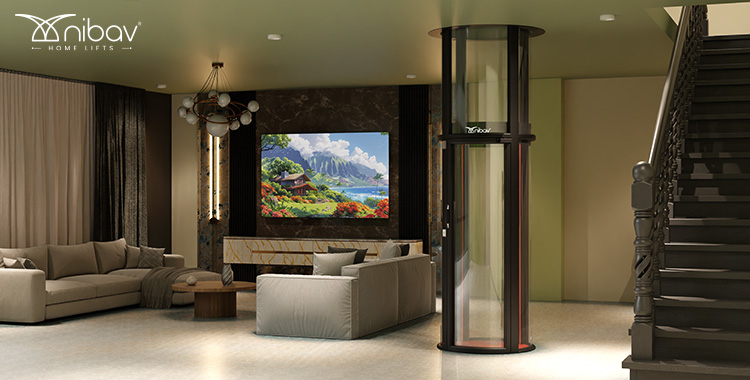
Table of Contents
If you’re looking for the best lift for home use and feel overwhelmed by the options, you’re not the only one. Sometimes, thinking about technical specs, different technologies, and conflicting opinions can render it impossible to find the best product.
The best home elevator would combine size, safety, cost, ease of install and fit your lifestyle—whatever that lifestyle is, whether it is providing accessibility, a means to age in place, or just daily convenience.
There are various types of residential lifts in the Australian market, but pneumatic vacuum lifts provide the greatest balance of performance, aesthetics and practicality.
They’re sleek, compact and designed for modern homes—especially when compared to big, bulky traditional lifts and installations requiring permissions, higher costs, and/or longer maintenance requirements.
But let’s step back for a moment and run through the lift types available so you can make an informed decision about the best model for your home, budget and future.
Types of Home Lifts
You’ll mainly find five distinct types of residential lifts, each functioning differently. Each lift is designed for many different use cases, budgets, and home types.
1. Hydraulic Home Lifts
Hydraulic home lifts operate using a hydraulic piston under the lift, moving via fluid pressure. This lift usually needs a pit underneath the hydraulic lift shaft. There is sometimes also a separate machine room for lift equipment.
Pros: High load capacity, smooth movement, supports heavy usage
Cons: Requires significant construction, uses oil, higher maintenance, needs machine room
2. Traction Lifts
Traction elevators use ropes or belts, with counterweights, to move the lift car, and are typically powered by an electric motor. While traction elevators are used primarily in commercial buildings, some larger homes are installing them as well.
Pros: Long-lasting, energy-efficient over time, smooth ride
Cons: Requires shaft and clearance for headroom, not as straightforward to install, more expensive
3. Chain-Driven Lifts
Instead of ropes, these lifts use chains to raise and lower the cabin. They are durable and often used for transporting heavier loads.
Pros: Lower upfront cost than traction, strong lifting capacity
Cons: Can be noisy, more frequent servicing required, not ideal for quiet households
4. Screw-Driven Lifts
Screw-driven lifts use a rotating screw shaft to move the platform up and down. These are commonly used in smaller homes due to their space-saving design.
Pros: Doesn’t need a pit or machine room, easy to fit in tight spaces
Cons: Slower travel speed, higher noise during movement, can feel less smooth
5. Pneumatic Vacuum Lifts
These advanced lifts work using air pressure to move the elevator car within a transparent tube. They are completely self-supporting and don’t require any complex infrastructure.
Pros: Shaftless design, minimal construction, quick install, low power use, modern appearance
| Lift Type | Space Required | Installation Time | Maintenance | Energy Use | Noise | Best For |
|---|---|---|---|---|---|---|
| Hydraulic | High | Long (weeks/months) | High | High | Moderate | Large homes with spacious layouts |
| Traction | High | Long | Medium | Low | Low | Multi-storey homes or buildings |
| Chain-Driven | Medium | Medium | High | Moderate | High | Heavy-duty or warehouse-style needs |
| Screw-Driven | Low | Medium | Medium | Moderate | Moderate | Homes with space constraints |
| Pneumatic Vacuum | Very Low | Very Fast (3–4 days) | Low | Very Low | Low | Modern homes, quick installations |
Factors to Consider Before Choosing a Home Lift
Before you invest in a home elevator, it’s important to understand what will work best for your space, your family, and your goals. Here are the top factors to keep in mind when you want to find the best lift for home use:
1. Space Availability
Do you have the space for a traditional lift with a shaft and pit? Or would a compact, self-supporting model work better? Vacuum lifts require very little space, making them ideal for retrofits or smaller homes.
2. Purpose & Usage
Consider how you’ll use your lift. Is it for daily convenience, for transporting groceries, or to help someone with mobility issues? A sleek pneumatic lift works for light to moderate daily use.
3. Budget
Initial cost is just one part of the equation. Installation, structural changes, energy use, and maintenance all add up. Pneumatic lifts may cost more upfront than very basic models, but their minimal installation costs and low energy use can make them more affordable overall.
4. Installation Time
Need a lift installed fast? Traditional lifts can take weeks or months to plan, build, and complete. Pneumatic models, however, can be installed in 3–4 days with minimal disruption.
5. Safety Features
Look for emergency features like auto-descent, battery backup, and interlocking doors. Vacuum lifts are known for safety because they don’t rely on pulleys or counterweights and use gravity to return to the lowest level in case of power failure.
6. Maintenance Requirements
Every lift needs maintenance—but how often and how intensive will that be? Pneumatic lifts have fewer mechanical parts, which means less wear and tear, less oil, and fewer service visits.
Why a Pneumatic Vacuum Lift is the Best Lift for Home Use
While there’s no one-size-fits-all answer, pneumatic vacuum lifts come incredibly close. For most homeowners, they offer the perfect balance between style, functionality, and convenience. Here’s a deeper look at why they stand out:
1. Minimal Space, Maximum Impact
Vacuum lifts need no shaft, no pit, and no machine room. That means they can be placed in spots where other lifts simply won’t fit—ideal for renovations or smaller homes where every square metre counts.
2. Quick & Clean Installation
Their modular, plug-and-play design means you avoid the dust, noise, and structural stress of other elevator types. Most installations are completed in 4–5 days, making it one of the fastest upgrades you can make.
3. Low Power, High Efficiency
They only use electricity while ascending. Descending is powered by air pressure and gravity, leading to much lower power bills. For eco-conscious homeowners, this is a major win.
4. Safety by Design
Pneumatic lifts offer one of the safest ride experiences available. If there’s ever a power failure, the elevator simply and safely descends to the ground floor—ensuring the user is never trapped.
5. Sleek Aesthetics
Modern homes deserve modern solutions. With a transparent, futuristic tube design and ultra-minimal footprint, these lifts are as much a design feature as a functional tool.
6. Accessibility Without Compromise
Whether it’s ageing in place, recovering from injury, or future-proofing your home, vacuum lifts help maintain independence with ease of access—without sacrificing style or space.
Conclusion: What’s the Best Lift for Home Use?
The best lift for your home is the one that fits your space, budget, and lifestyle. For Australian homeowners who want a future-ready, aesthetically pleasing, and efficient elevator, pneumatic vacuum lifts are emerging as the go-to option.
They’re fast to install, easy to maintain, safe, and stylish—all while requiring less structural disruption. For most modern homes, this makes them the smartest and most sustainable choice.
If you’re planning a renovation, designing a new home, or thinking long-term about accessibility, now’s the perfect time to consider how a home lift can improve both your quality of life and your property value.

Thomas Baker
The Nibav lift has completely transformed our home’s interior. Its transparent design blends beautifully with our décor and adds a futuristic touch. It’s not just a convenience—it’s a statement piece. I’m impressed with both its looks and performance.
Benjamin Clark
What impressed me most was the Nibav team’s support. They followed up after installation to ensure everything was perfect. The lift itself runs smoothly and requires minimal maintenance. A fantastic company to work with.
Zoe Turner
I’m amazed by how silent the Nibav lift is. It glides effortlessly and looks elegant with its transparent cylindrical design. The emergency safety features make me feel secure, especially when my kids use it. It’s both a safety upgrade and a design masterpiece.